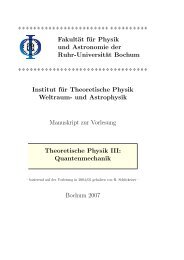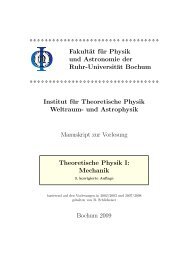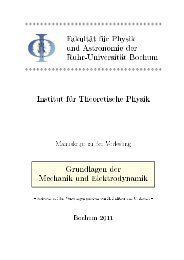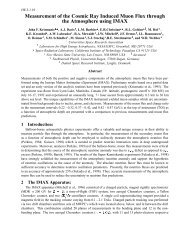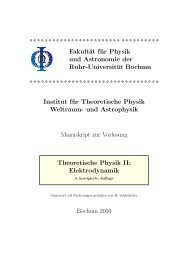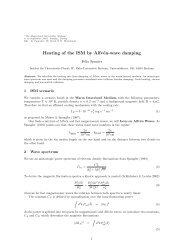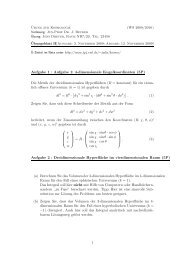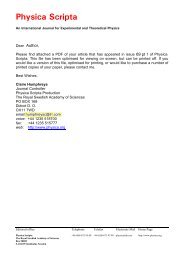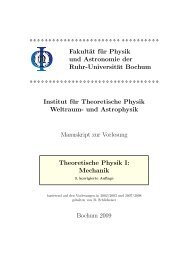pdf here - Theoretische Physik IV - Ruhr-Universität Bochum
pdf here - Theoretische Physik IV - Ruhr-Universität Bochum
pdf here - Theoretische Physik IV - Ruhr-Universität Bochum
Create successful ePaper yourself
Turn your PDF publications into a flip-book with our unique Google optimized e-Paper software.
propagation speed and the positron-to-electron density ratio on the soliton<br />
width, as obtained from the relation W = p 4B=U 0 . It is clear that the positive<br />
(pulse) soliton width decreases with , while the opposite happens to negative<br />
(hole) solitons. Furthermore, the soliton width becomes wider by increasing the<br />
value of . The electrostatic potential pulse excitations ' (1) are depicted in Fig.<br />
2, against the radial coordinate r and the polar angle : It is observed that the<br />
propagation of both positive and negative soliton pulses in the radial direction is<br />
slightly distorted and accelerated due to (weak) angular, i.e., non-gyrotropic effects.<br />
Note that the real value of the electrostatic potential is (T e =e)' (1) 86:2' (1)<br />
(in KVolts), for an electron temperature of 10 9 K [19].<br />
<strong>IV</strong>.<br />
EXCITATIONS AT CRITICALLY NONLINEAR PLASMA COMPOSITIONS<br />
Summarizing the above analysis, we have developed a theory for nonlinear excitations in<br />
e-p-i plasmas, in fact reducing the system of plasma-‡uid equations to a CKP equation. An<br />
appropriate travelling-wave ansatz has enabled us to reduce the CKP equation further to a<br />
KdV equation, which features a nonlinearity coe¢ cient A given by Eq. (18). The solutions<br />
thus obtained are sustained by a balance between dispersion (expressed by the coe¢ cient<br />
B) and nonlinearity (expressed by A). An important question arises <strong>here</strong> regarding the<br />
strength of the nonlinearity. Speci…cally, one may wonder whether the coe¢ cient A may<br />
acquire small values, and what happens then. Interestingly, this appears to be the case in<br />
accretion disks. For instance, adopting values from Ref. [19] for i = 1=3; = 0:1; and<br />
= 2:38 we obtain A = 0:1. T<strong>here</strong>fore, we may anticipate that higher-order nonlinearity<br />
enters into play, if A is of the order of, say, ". To answer this question, one should obtain<br />
an appropriate equation which describes the evolution of the system in this case. In this<br />
section, we shall t<strong>here</strong>fore explicitly assume that A ", in order to examine the behavior<br />
of the nonlinear waves in an e-p-i plasma at critical compositions. A similar discussion has<br />
been carried out in multi-species e-i plasmas; see, e.g., in Ref. [23].<br />
Adopting a slightly di¤erent version of the reductive perturbation technique, we now<br />
introduce stretched space-time coordinates<br />
= "(r t) ; = " 1 and = " 3 t : (25)<br />
9



